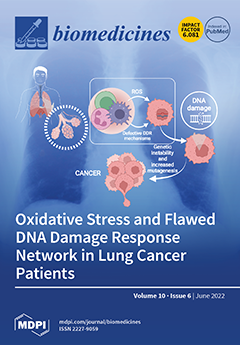Sporadic vascular malformations (VMs) are a large group of disorders of the blood and lymphatic vessels caused by somatic mutations in several genes—mainly regulating the RAS/MAPK/ERK and PI3K/AKT/mTOR pathways. We performed a cross-sectional study of 43 patients affected with sporadic VMs, who had
[...] Read more.
Sporadic vascular malformations (VMs) are a large group of disorders of the blood and lymphatic vessels caused by somatic mutations in several genes—mainly regulating the RAS/MAPK/ERK and PI3K/AKT/mTOR pathways. We performed a cross-sectional study of 43 patients affected with sporadic VMs, who had received molecular diagnosis by high-depth targeted next-generation sequencing in our center. Clinical and imaging features were correlated with the sequence variants identified in lesional tissues. Six of nine patients with capillary malformation and overgrowth (CMO) carried the recurrent
GNAQ somatic mutation p.Arg183Gln, while two had
PIK3CA mutations. Unexpectedly, 8 of 11 cases of diffuse CM with overgrowth (DCMO) carried known
PIK3CA mutations, and the remaining 3 had pathogenic
GNA11 variants. Recurrent
PIK3CA mutations were identified in the patients with megalencephaly–CM–polymicrogyria (MCAP), CLOVES, and Klippel–Trenaunay syndrome. Interestingly,
PIK3CA somatic mutations were associated with hand/foot anomalies not only in MCAP and CLOVES, but also in CMO and DCMO. Two patients with blue rubber bleb nevus syndrome carried double somatic
TEK mutations, two of which were previously undescribed. In addition, a novel sporadic case of Parkes Weber syndrome (PWS) due to an
RASA1 mosaic pathogenic variant was described. Finally, a girl with a mild PWS and another diagnosed with CMO carried pathogenic
KRAS somatic variants, showing the variability of phenotypic features associated with
KRAS mutations. Overall, our findings expand the clinical and molecular spectrum of sporadic VMs, and show the relevance of genetic testing for accurate diagnosis and emerging targeted therapies.
Full article






